Photography by Chris Lake
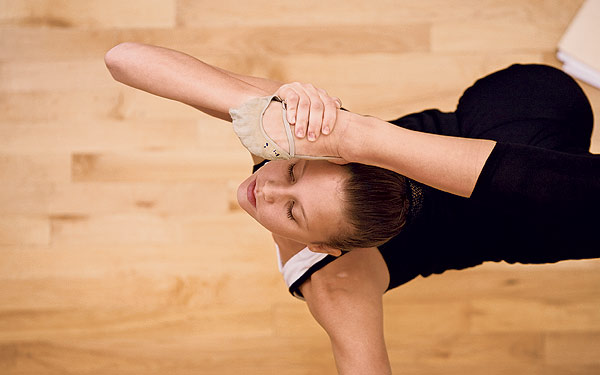
The scene inside the Glenview Park Center does not immediately call to mind Olympic glory. It is quiet, even mellow. A dozen girls are working out, mostly stretching and holding Pilates-like poses in a mat-lined gym that is only provisionally partitioned from the basketball court next door. Above their heads, a few senior citizens make their way slowly around the second-floor jogging track.
|
A single coach—tall and lean, with the elegant posture of a ballerina—calls several of the young women together and, with a few words, starts them on the routine that will occupy them for the next hour: tumbling and tossing ropes back and forth to one another in an intricately choreographed pattern. They repeat each sequence of the routine ten times, keeping count themselves, matching their pace to a musical soundtrack playing only in their minds. The complexity of what they're doing is almost mind-boggling: Moving together in a straight line down the length of the mat, the girls simultaneously keep five ropes in the air, catching and tossing them to each other in rapid succession—it's five-person juggling with complicated, synchronized dancing thrown in. The longer one watches, the more impossible it seems. But, more times than not, they get it exactly right. Then they count off and do it again.
Meanwhile, another girl, 14-year-old Marlee Shape, is tossing a similar rope on her own, throwing it high in the air and executing a complicated series of poses before lying down on the mat, knees bent, and catching it, seemingly effortlessly, with a single, outstretched arm. Occasionally, the rope gets caught in the rafters of the high ceiling, where the basketball backboards have been cranked up. Unfazed, she grabs a plastic hoop from the corner, throws it upwards, and dislodges the rope on the first try.
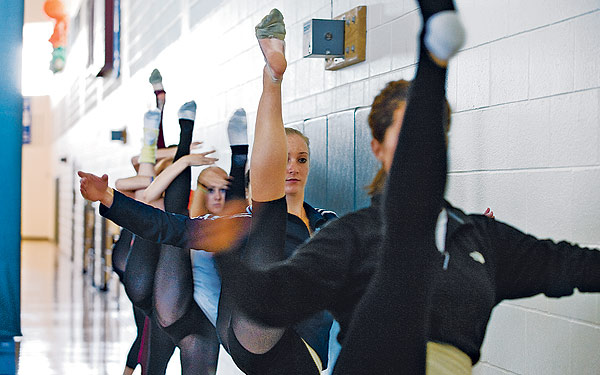
The subdued mood of the place changes only slightly when a second coach enters. "The weather in Greece is beautiful," she announces. "Natalia says hi to you. And there is no air conditioning in the gym there." This elicits a collective groan. The girls have questions, too, about the wildfires that lately have been raging across Greece, but the coach pointedly ignores them. Though these young women are the top American athletes in their sport, about to head to the world championships in Patras, Greece, where they have a chance to earn a place in the 2008 Olympics, there is no room here for anything even remotely resembling diva-dom.
That's because their sport is rhythmic gymnastics. Not, as they often find themselves explaining, "gymnastic gymnastics," the sport with the balance beam and the parallel bars and all that. That sport, technically, is called "artistic gymnastics." Rhythmic gymnastics, by contrast, consists of floor exercises, done with a variety of objects such as ropes, balls, clubs, hoops, and ribbons. "Oh, yes," people will generally say, "the thing with the ribbons."
While most Americans can name at least one artistic gymnast of their generation, usually an Olympic champion—Cathy Rigby or Mary Lou Retton or Kerri Strug—the U.S. has yet to produce a single Olympic champion in rhythmic gymnastics. In fact, in some years, the United States hasn't even qualified to compete in the Olympics in rhythmic. (Bulgaria, on the other hand, is a powerhouse. As is Belarus.)
Around the world, rhythmic is at least as popular as artistic gymnastics, and in Eastern Europe it's much more so. More than 30 countries compete in the rhythmic world championships, twice as many as in artistic. The United States, though always something of an underdog, used to hold its own in rhythmic competitions, as immigrants who had grown up with the sport organized clubs and training programs, through which their children competed on behalf of their new homeland. But with the breakup of the Soviet Union, the international competitive landscape changed forever as each new republic quickly formed its own team. The Americans, with their informal club system, were no match for girls trained in those state-sponsored and highly centralized programs.
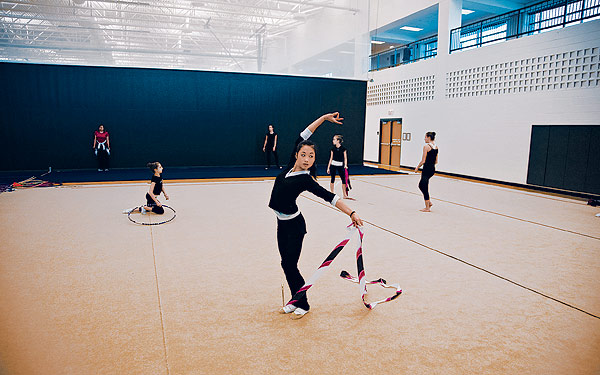
With the exception of one rather bizarre offshoot in Japan, rhythmic is a women-only sport. This has limited its growth in post–Title IX America, where, generally speaking, if guys don't do it, it's not a sport. There is also, it must be said, a certain silliness quotient attached to any human endeavor involving a sparkly leotard and a plastic hoop. Still, 1,100 young women and girls have registered with USA Gymnastics, the sport's governing body. And, somewhat amazingly, the epicenter of American rhythmic gymnastics happens to be located in Chicago's northern suburbs. It is, in fact, right inside this rather modest-looking Glenview park district gym.
North Shore Rhythmics, the club practicing here, is the home base of the sport's senior national champion, its junior national champion, and its group champions, the girls practicing the rope routine. Natalia Klimouk, the head coach who runs the club, has been named the sport's "coach of the year" three times in the past decade.
The club itself is only two years old, formed when Klimouk left another north suburban club, which has since disbanded, to strike out on her own. But its dominance of the sport is unquestioned. "If our country were represented by a single club, that would be the club," says Caroline Hunt, the rhythmic program director at USA Gymnastics.
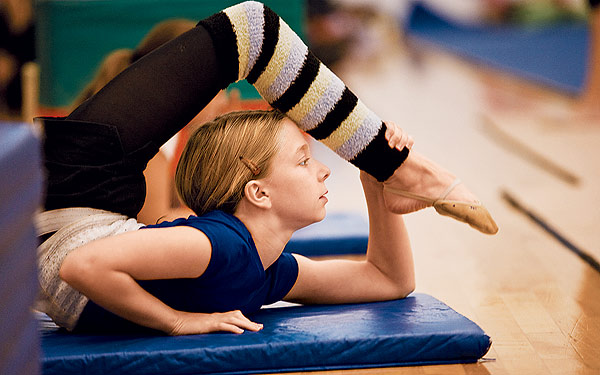
Much of this success can be attributed to Klimouk herself, who came to the United States in 1994 from Belarus, where she was a coach for the national team. She is the kind of coach, considered rhythmic's Bela Karolyi, who seems able to find something special in every girl she coaches.
But the North Shore's status as the center of the U.S. rhythmic community predates Klimouk's arrival. Since 1990, when Hunt herself, a Winnetka native and New Trier graduate, was junior national champion, the North Shore suburbs have been home to at least one champion or national team member (the first- through fourth-ranked gymnasts) every year, usually more. At last year's national championships, 12 of 44 individual competitors hailed from Chicago's northern suburbs.
"In the cities where there were strong communities of Eastern Europeans, there were strong rhythmic communities," says Hunt, mentioning New York and Los Angeles, each home to six rhythmic clubs. She adds, however, that Chicago, with only four clubs—three in the northern suburbs and one in Downers Grove—dominates the national scene. The immigrant communities certainly have something to do with it, as does the affluence of the suburbs where they have settled: As a club sport, rhythmic requires most gymnasts, except the top-ranked girls, to pay all of their own training and travel expenses. The leotards worn in competitions run around $1,200 apiece.
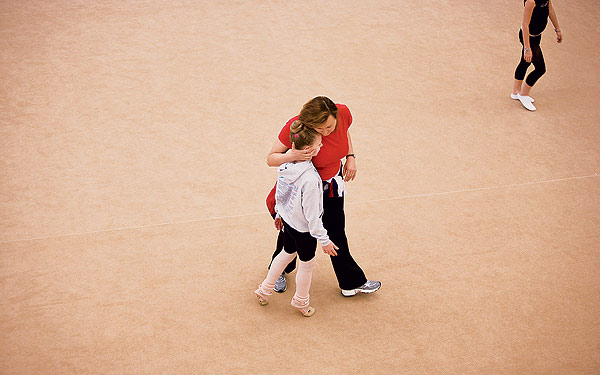
Natalia Klimouk, the head coach of North Shore Rhythmics, encourages a young gymnast.
There's something else, though, that has established the North Shore as rhythmic's U.S. hub: the parents.
"Let's say that not everyone in other parts of the country has been so aggressive about finding opportunities for their kids to compete," says Natalie Stacker, the president of North Shore Rhythmics' parents' association. "Some of us just have a little more marketing savvy, I guess."
Stacker's daughter, Brenann, a high-ranked competitor and longtime national team member, retired from the sport last year and is now a student at Tufts University. Stacker believes her daughter's rhythmic experience helped when she applied to colleges. "She sent college-colored ribbons to the admissions officers with instructions on how to use them," Stacker says. "She got in everywhere she applied."
Unlike, say, soccer, the relatively small pond that is rhythmic gymnastics in the United States allows girls who might not be obviously gifted athletes to compete at high levels. With the right coaching and the drive to practice five to six hours a day, a spirited and determined young woman has a decent chance of making it into the sport's elite national ranks.
"When I talk to the Russian coaches," Klimouk says, "they say they love to watch the American kids because they might not be as talented as the Russian girls, but, seeing them, you see how much average kids can really do." The sport's reigning national champion, Lisa Wang of Buffalo Grove, is such an example, Klimouk says. "Lisa, naturally, is not that talented," Klimouk says bluntly, an assessment belied by the balletic grace and mind-blowing flexibility Wang demonstrates when she performs, "but she made her body like this; she made herself a champion."
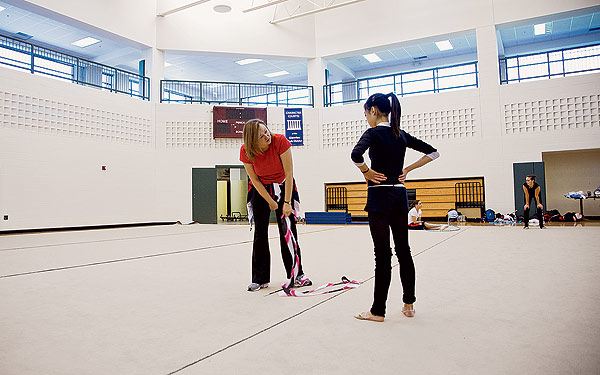
Klimouk and Lisa Wang, the sport's reigning national champion, discuss the mechanics of a particularly challenging new sequence.
In Europe, Klimouk says, the tiny Wang—she stands about five feet tall—would not have been encouraged, or even allowed, to train in rhythmic. But in the United States, she competes alongside national teammate Ava Gehringer, of Evanston, who stands five feet ten and a half and cuts the long, lean profile typical of European competitors. What Wang and Gehringer seem to have in common, though—and this is a trait that seems present in many U.S. rhythmic competitors—is unyielding self-discipline.
It is the kind of discipline that keeps a dozen girls practicing on a sunny Thursday afternoon, after a full day of school, when their two coaches, Dani Takova and Angelina Yovcheva (Klimouk is already in Greece, with Wang and Gehringer), are huddled together in a backroom, out of sight. Takova, acupuncture textbook in hand, is using an electric needle to treat Yovcheva's sore back.
Yovcheva, who competed for the Bulgarian national team before becoming a coach, is in charge of training North Shore Rhythmics' competitive "group." (Rhythmic events feature individual and group performances.) The young women in North Shore's group—including 17-year-old Kristian Brooks, formerly a highly accomplished individual competitor, who moved from Michigan to train here—have given up their individual careers to compete together. Though they are the top-ranked team in the United States, almost no one expects them to do well enough in Greece to qualify for an Olympic berth. (Only one U.S. group has ever made it; that was in 1996, when Atlanta hosted the games.)
Still, the girls keep tossing and catching and tumbling and counting. Because they leave for Greece in two days. And you never know.
The country's best hope at the world championships is Wang, who competes as an individual. She has already proved herself in international competition, winning the Pan-American games, and, deferring her acceptance to Yale University for a year, she has been training full-time since graduating early from Stevenson High School in December. Gehringer, who is there only as an alternate, has also put off college for a year. "A lot of people really look down on that decision," she says, but, while she is eager to begin her studies at New York University, she found she just couldn't leave rhythmic without giving herself one more chance to become a champion.
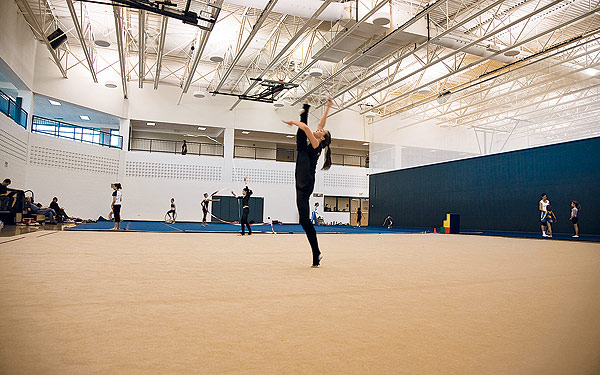
At five feet ten, Ava Gehringer, of Evanston, typifies the long, lean figure of the sport's typical competitor.
The North Shore group—Brooks, plus Stephanie Flaksman of Northbrook, Krista Johnson of Downers Grove, Nicole Kowalik of Libertyville, Marina Ljuboja of Highland Park, Michelle Wojtach of Glenview, and Kristin Kaye of Northbrook—arrived in Greece without much fanfare. Unlike U.S. athletes arriving at almost any other world competition, they were not only underdogs, but unknowns. They had a couple of days to practice the routine they had perfected at home and adjust to the un-air-conditioned climate.
They knew they had to give the performance of their lives, but even a flawless routine might not impress the international judges as sufficiently technically challenging. That was out of their control, so they fixed their smiles in place, pinned their hair back perfectly, and gave it everything they had.
In the end, they finished 23rd, out of 27.
Among the individual competitors, Wang finished 31st, out of 128. If she had made it to 24th place, a difference of 0.3 points, she would have advanced to the second round, where the top 20 finishers earned Olympic berths. Now shunted from the direct road to Beijing in 2008, Wang had one last hope: a remaining single "wildcard spot" that can be offered by the International Olympic Committee to an outstanding athlete who has otherwise failed to qualify. As the gold medalist at this past summer's Pan-American games, Wang was certainly a contender for the privilege.
So, when she returned to Buffalo Grove, Wang maintained her six-hour-a-day practice regimen.
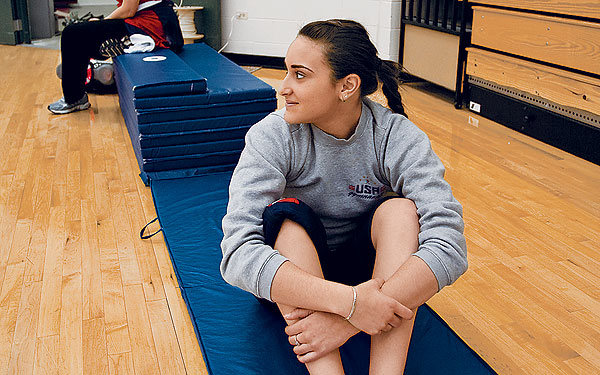
Fourteen-year-old Marlee Shape, the U.S. junior champion, takes a break.
"It's kind of strange," she said in a quiet voice, taking a break from her workout on a late autumn afternoon. "I've always been motivated by a goal, working toward a goal, and now it's sort of, well, what do I do now? I feel like my body could do more and I don't feel like I'm ready to quit. But I'm not sure if I could stick it out for five more years to try for the Olympics again."
Wang said she didn't regret her decision to devote so much of her adolescence to her sport, but then added, "There are some things. I missed prom. I missed graduation. I missed Homecoming. But these opportunities I've had are just dreams for most people." A few weeks later, Wang learned that she would not be going to the Olympics: Through a voice mail message, she found out that the U.S. Olympic Committee declined to pursue the wildcard berth on her behalf. Rueful but upbeat, Wang said she will fill the rest of her year by performing in smaller international competitions and exhibitions. She will not stop practicing.
With no U.S. gymnast participating in the 2008 Olympics, the attention of Caroline Hunt and the rest of the U.S. rhythmic community has already shifted to preparing for the 2012 games, set to be held in London. This does not, of course, mean that North Shore Rhythmics will be out of the spotlight. The club is home to the current junior national champion—Buffalo Grove's Marlee Shape—and she is widely considered to be the strongest contender to represent the U.S. in the London games.
Shape was busy, tossing her rope to the ceiling, knocking it down with a hoop, as the North Shore group prepared for the world championships a few months ago. But she was also watching them. She knows her turn is coming.


